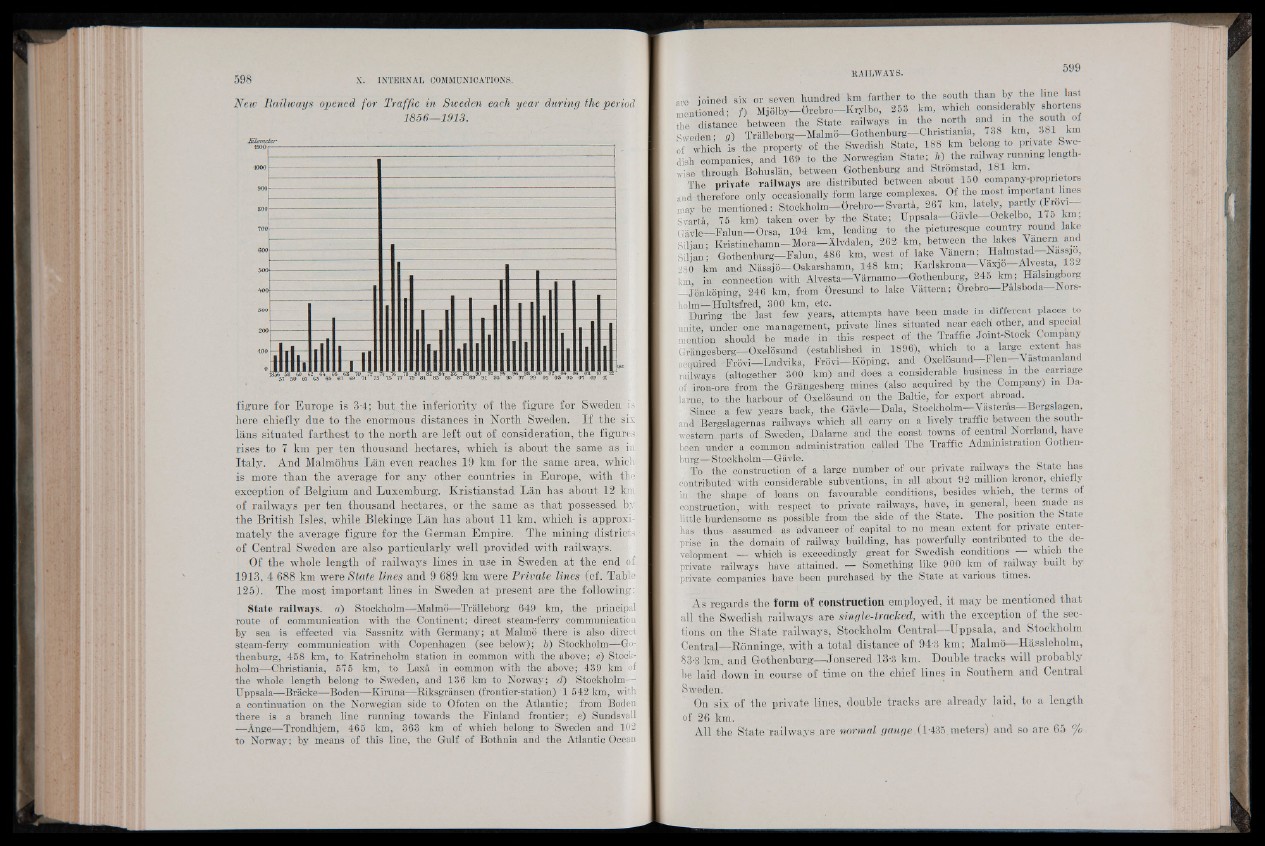
New Railways opened for Traffic in Sweden each year during the period
1856— 1913.
15lomdcr
figure for Europe is 3-4; but the inferiority of the figure for Sweden is
here chiefly due to the enormous distances in North Sweden. I f the six
Ians situated farthest to the north are left out of consideration, the figures
rises to 7 km per ten thousand hectares, which is about the same as in
Italy. And Malmohus Lan even reaches 19 km for the same area, which-
is more than the average for any other countries in Europe, with the
exception of Belgium and Luxemburg. Kristianstad Lan has about 12 km
of railways per ten thousand hectares, or the same as that possessed by
the British Isles, while Blekinge Lan has about 11 km, which is approximately
the average figure for the German Empire. The mining districts
of Central Sweden are also particularly well provided with railways.
Of the whole length of railways lines in use in Sweden at the end of
1913, 4 688 km were State lines and 9 689. km were Private lines (cf. Table
125). The most important lines in Sweden at present are the following:
State railways, a) Stockholm—Malmo—Tralleborg 649 km, the principal
route of c om m u n ic a tio n with the Continent; direct steam-ferry communication
by sea is effected via Sassnitz with Germany; at Malmo there is also direct:
steam-ferry communication with Copenhagen (see below); 6) Stockholm—Gothenburg,
458 km, to Katrineholm station in common with the above; c) Stockholm—
Christiania, 575 km, to Laxa in common with the above; 439 km of
the whole length belong to Sweden, and 136 km to Norway; d) Stockholm—
Uppsala—Bracke—Boden—Kiruna—Riksgransen (frontier-station) 1 542 km, with
a continuation on the Norwegian side to Ofoten on the Atlantic; from Boden
there is a branch line running towards the Finland frontier; e) Sundsvall
—Ange—Trondhjem, 465 km, 363 km of which belong to Sweden and 102
to Norway; by means of this line, the Gulf of Bothnia and the Atlantic Ocean
are joined six or seven hundred km farther to the south than by the Ime last
mentioned; f) Mjölby—Örebro—Krylbo,. 253 km, which considerably shortens
the distance between the Stata. railways in the north and m the south of
Sweden- q) Tralleborg—Malmö—Gothenburg—Christiania, 738 km, 381 Km
of ’which is the property of the Swedish State, 188 km belong to private Swedish
companies, and 169 to the Norwegian State; h) the railway running lengthwise
through Bohuslän, between Gothenburg and Stromstad, 181 km.
The private railways are distributed between about 150 company-propnetors
and therefore only occasionally form large complexes. Of the most important lines
may be mentioned: Stockholm—Örebro—Svartà, 267 km, lately, flOTÜJ
Svartà, 75 km) taken over by the State; Uppsala—Gavle—Ockelbo, 175 km,
Qävle—Falun—Orsa, 194 km, leading to the picturesque country round lake
Siljan; Kristinehamn-Mora—Alvdalen, 262 km, between the lakes Vanera and
Siljan; Gothenburg—Falun, 486 km, west of lake Vanern; Ilalmstad—Nassjo,
28® km and Nässjö—Oskarshamn, 148 km; Karlskrona—Vaxjo Alvesta,
I I in connection with Alvesta—Värnamo—Gothenburg, 245 km; Halsmgborg
Jönköping, 246 km, from Öresund to lake Vättern; Örebro Palsboda NorsholmSHultsfred,
300 km, etc. _
During th e ' last few years, attempts have, been made m different places to
unite, under one management, private lines situated near each other, and special
mention should be : made in this respect of the Traffic Joint-Stock Company
Grängesberg—Oxelösund (established in 1896), which to a large extent has
acquired -Frö p jfLu d v ik a, Frövi—Köping, and Oxelösund—Flen—Vastmanland
railways (altogether 300 k m ) a n d d o e s a considerable business, in the carriage
of iiron-ore from the Grängesberg mines (also acquired by the Company) in Da-
lame, to the harbour of Oxelösund on the Baltic, for export abroad.
Since a few years back, the Gavle—Dala, Stockholm—Västeras—Berplagen,
and Bergslagernas railways which all carry on a'lively traffic between thè south-
western, parts of Sweden, Dalarne and the coast towns,df central Non-land, have
been under a common administration called The Traffic Administration Gothenburg—
Stockholm—Gavle.
To thè' construction of a large number of our private railways the State 1ms
contributed "With considerable subventions, in all about 92 million kronor, chiefb’
in the shape of loans, on favourable conditions,' besides which, the terms of
construction, with respect to private railways, have, in general, been made as
little burdensome as possible from the side of the State. The position the State
has thus ■ assumed, as advancer of capital to no mean extent for private enterprise
in the domain of railway building, has powerfully contributed to the development
— which is exceedingly great for Swedish conditions — which the
private railways have attained. — Something like 900 km of railway built bj
private companies have: been purchased by the State at various times.
As regards the form of construction employed, it may he mentioned that
all thè Swedish railways are single-tracked, with the exception of the sections
on the State railways, Stockholm Central— Uppsala, and Stockholm
Central-—Rönninge, with a total distance of 94-8 km; Malmö Hässleholm,
83-3 km, and Gothenburg—Jonsered 13-3 km. Double tracks will probably
he laid down in course of time on the chief lines in Southern and Central
Sweden.
On six of the private lines, double tracks are already laid, to a length
of 26 km. , ,
All the State railways are normal gauge (1-435 meters) and so are 65 °/o